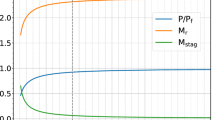Abstract
Nitrogen is proposed as a suitable driver gas candidate for the operation of free-piston-driven shock tunnels at low total enthalpies. When compressed adiabatically, nitrogen has a lower speed of sound than the commonly used driver gases, e.g., argon and helium, thus providing the ability to achieve tailored conditions and longer test durations at lower enthalpies. This paper describes the methodology used to design operating conditions using nitrogen as the driver gas and presents an experimental and numerical demonstration of its use to achieve tailored conditions in a free-piston-driven shock tunnel. In this demonstration, the useful test flow duration was extended from less than 0.5 ms to 4 ms based on a constant-nozzle-supply-pressure criterion for tests at total enthalpies of 1.6 MJ/kg. The same design methodology was then used to develop different nitrogen–argon driver conditions for tailored operation in the free-piston-driven shock tunnel T4 for enthalpies spanning from 1.6 to 3.2 MJ/kg. With a nitrogen driver gas, T4, which was originally designed for operation up to Mach 25 flight conditions, can now operate at conditions as low as an equivalent flight Mach number of 5.5. This is significant because the experimental results, supported by numerical simulations, clearly demonstrate that nitrogen can be used as a driver gas in free-piston-driven shock tunnels to maximise the duration at which test conditions are held constant when testing at low total enthalpies.













Similar content being viewed by others
Notes
Region 1 denotes the driven gas in its original state, region 4 the driver gas in its original state, and region 5 the state of the driven gas after it has been processed by the reflected shock.
References
Stalker, R.J., Paull, A., Mee, D.J., Morgan, R.G., Jacobs, P.A.: Scramjets and shock tunnels—the Queensland experience. Prog. Aerosp. Sci. 41(6), 471–513 (2005). https://doi.org/10.1016/j.paerosci.2005.08.002
Matsuo, K., Kage, K., Kawagoe, S.: The interaction of a reflected shock wave with the contact region in a shock tube. Bull. JSME 18(18), 681–688 (1975)
Nishida, M.: Shock tubes. In: Ben-Dor, G., Igra, O., Elperin, T. (eds.) Handbook of Shock Waves, vol. 1, 1st edn, pp. 553–585. Academic Press, New York (2001)
Jacobs, P.A., Morgan, R.G., Stalker, R.J., Mee, D.J.: Use of argon-helium driver-gas mixtures in the T4 shock tunnel. In: Brun, R., Dumitrescu, L.Z. (eds.) Shock Waves @ Marseille I (19th International Symposium on Shock Waves), vol. 1, pp. 263–268. Springer, Heidelberg, Germany (1993). https://doi.org/10.1007/978-3-642-78829-1_42
Lavery, I.: A nitrogen driver for the T4 shock tunnel. Bachelor of engineering (Honours) thesis, The University of Queensland, Queensland, Australia (1993)
Hess, S.: A low enthalpy test condition for the T4 shock tunnel. Diploma thesis, The University of Queensland, Queensland, Australia (2009)
Hong, Z., Davidson, D.F., Hanson, R.K.: Contact surface tailoring condition for shock tubes with different driver and driven section diameters. Shock Waves 19, 331–336 (2009). https://doi.org/10.1007/s00193-009-0212-z
Stalker, R.J., Morgan, R.G.: The University of Queensland free piston shock tunnel T4—initial operation and preliminary calibration. 4th National Space Engineering Symposium, pp. 182–198. Institution of Engineers, Australia, Adelaide, South Australia, Australia (1988)
Doherty, L.J.: An experimental investigation of an airframe integrated three-dimensional scramjet at a Mach 10 flight condition. PhD thesis, The University of Queensland, Queensland, Australia (2014). https://doi.org/10.14264/uql.2014.382
Itoh, K., Ueda, S., Komuro, T., Sato, K., Takahashi, M., Miyajima, H., Tanno, H., Muramoto, H.: Improvement of a free piston driver for a high-enthalpy shock tunnel. Shock Waves 8, 215–233 (1998). https://doi.org/10.1007/s001930050115
Jacobs, P.A.: Quasi-one-dimensional modeling of a free-piston shock tunnel. AIAA J. 32(1), 137–145 (1994). https://doi.org/10.2514/3.11961
Gildfind, D.E., Jacobs, P.A., Morgan, R.G., Chan, W.Y.K., Gollan, R.J.: Scramjet test flow reconstruction for a large-scale expansion tube, Part 1: quasi-one-dimensional modelling. Shock Waves 28, 877–897 (2018). https://doi.org/10.1007/s00193-017-0785-x
Stalker, R.J.: A study of the free-piston shock tunnel. AIAA J. 5(12), 2160–2165 (1967). https://doi.org/10.2514/3.4402
Hornung, H.G.: The piston motion in a free-piston driver for shock tubes and tunnels. GALCIT Report FM 88-1, Graduate Aeronautical Laboratories, California Institute of Technology (1988)
Acknowledgements
W. Chan gratefully acknowledges the Australian Defence Science & Technology Group for funding his University of Queensland Post-doctoral Fellowship, during which this work was conducted. R. Whitside gratefully acknowledges the support of the Australian Government Research Training Program Scholarship and the Natural Sciences and Engineering Research Council of Canada (NSERC) Postgraduate Scholarship–Doctoral.
Author information
Authors and Affiliations
Corresponding author
Additional information
Communicated by K. Hannemann.
Publisher's Note
Springer Nature remains neutral with regard to jurisdictional claims in published maps and institutional affiliations.
This paper is based on work that was presented at the 32nd International Symposium on Shock Waves, Singapore, July 14–19, 2019.
Appendix: T4 operation conditions for blended nitrogen and argon driver gases
Appendix: T4 operation conditions for blended nitrogen and argon driver gases
A summary of the nitrogen–argon driver conditions for T4 operation at a compression ratio of 60 is shown in Table 2. This also includes the existing pure argon and helium conditions for reference. For a given driver gas mixture and unscored mild steel diaphragm thickness, the reservoir (\(p_{\mathrm{Res}}\)) and compression tube (\(p_{\mathrm{CT}}\)) fill pressures are provided. The nominal burst pressure \(p_{4}\) for each diaphragm thickness is also provided.
Rights and permissions
About this article
Cite this article
Chan, W.Y.K., Whitside, R.W., Smart, M.K. et al. Nitrogen driver for low-enthalpy testing in free-piston-driven shock tunnels. Shock Waves 31, 541–550 (2021). https://doi.org/10.1007/s00193-021-01002-0
Received:
Revised:
Accepted:
Published:
Issue Date:
DOI: https://doi.org/10.1007/s00193-021-01002-0




